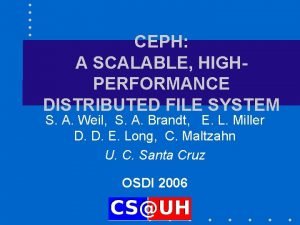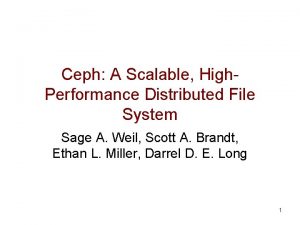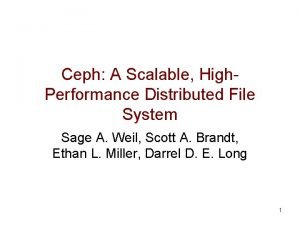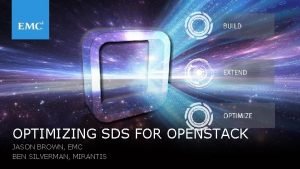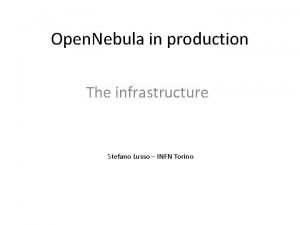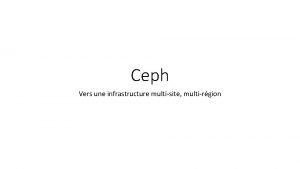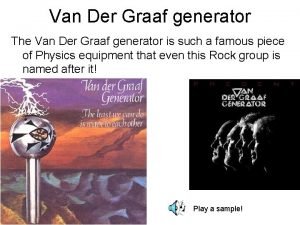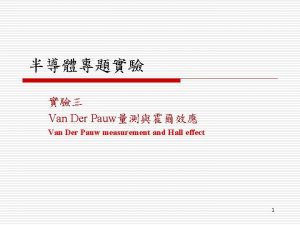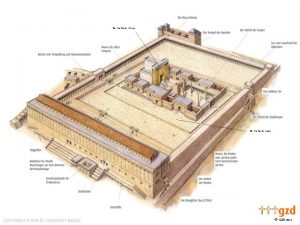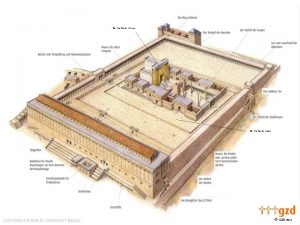Ceph CERN one year on Dan van der























- Slides: 23


Ceph @ CERN: one year on… Dan van der Ster (daniel. vanderster@cern. ch) Data and Storage Service Group | CERN IT Department HEPIX 2014 @ LAPP, Annecy

Ceph Architecture and Use-Cases Ceph @ CERN -- Dan van der Ster 2

Open. Stack + Ceph • Used for Glance Images, Cinder Volumes and Nova ephemeral disk (coming soon) • Ceph + Open. Stack offers compelling features: Co. W clones, layered volumes, snapshots, boot from volume, live migration Cost effective with Thin Provisioning • • ~110 TB “used”, ~45 TB * replicas on disk Ceph is the most popular network block storage backend for Open. Stack • http: //opensource. com/business/14/5/openstack-usersurvey Ceph @ CERN -- Dan van der Ster 3

Ceph at CERN • In January 2013 we started to investigate Ceph for two main use-cases: Block storage for Open. Stack • • Other options being Net. App (expensive, lock-in) and Gluster. FS Storage consolidation for AFS/NFS/… We built a 250 TB test cluster out of old CASTOR boxes, and early testing was successful so we requested hardware for a larger prototype… Ceph @ CERN -- Dan van der Ster 4

3 PB of Ceph 47 disk servers/1128 OSDs Dual Intel Xeon E 5 -2650 32 threads incl. HT Dual 10 Gig-E NICs Only one connected 24 x 3 TB Hitachi disks Eco drive, ~5900 RPM 3 x 2 TB Hitachi system disks Triple mirror 64 GB RAM 5 monitors Dual Intel Xeon L 5640 24 threads incl. HT Dual 1 Gig-E NICs Only one connected 2 x 2 TB Hitachi system disks RAID-1 mirror 1 x 240 GB OCZ Deneva 2 /var/lib/ceph/mon 48 GB RAM # df -h /mnt/ceph Filesystem Size Used Avail Use% Mounted on xxx: 6789: / 3. 1 P 173 T 2. 9 P 6% /mnt/ceph Ceph @ CERN -- Dan van der Ster 5

Deployment • Fully puppetized using forked upstream module: https: //github. com/cernceph/puppet-ceph • Automated machine commissioning and maintenance Add a server to the hostgroup (osd, mon, radosgw) OSD disks are detected, formatted, prepared, auth’d • • • Also after disk replacement Auto-generated ceph. conf Last step is manual/controlled: service ceph start Mcollective for bulk operations on the servers • • Ceph rpm upgrades daemon restarts Ceph @ CERN -- Dan van der Ster 6

A “Dashing” dashboard Code: https: //github. com/rochaporto/dashing-ceph Ceph @ CERN -- Dan van der Ster 7

SLS Monitoring http: //sls. cern. ch/sls/service. php? id=Ceph @ CERN -- Dan van der Ster 8

Example SLS plots Ceph @ CERN -- Dan van der Ster 9

Potential Use-Cases Ceph @ CERN -- Dan van der Ster 10

Ceph for Physics Data? • RADOS is not a drop-in HEP storage system • • • (EOS/Dcache/DPM/. . . ) on RBD would allow thin disk servers, but they still act as “gateways” to the data on Ceph • • No namespace Object size limitations No X 509/kerberos Much more … double/triple/quadruple network traffic Ceph. FS is NFS-like, but it lacks strong auth (among other things). See our dev blueprint: http: //wiki. ceph. com/Planning/Blueprints/Firefly/Strong_Auth. N_and_Auth. Z_for_Ceph. FS Ceph @ CERN -- Dan van der Ster 11

CASTOR & XRoot. D/EOS • Exploring RADOS backend for these storage systems • CASTOR needs raw throughput performance (to feed many tape drives at 250 MBps each). • • • XRoot. D/EOS may benefit from the lack of a namespace to store O(billion) objects • • Striped RWs across many OSDs are important. Rados Striper for CASTOR: https: //github. com/ceph/pull/1186 Bonus: also http/webdav with X 509/kerberos, possibly even fuse mountable. RADOS FS: https: //github. com/joaquimrocha/radosfs Xrootd Plugin: https: //github. com/joaquimrocha/xrootd-rados-oss Developments are exploratory / early stages. Ceph @ CERN -- Dan van der Ster 12

Throughput testing basic rados bench - saturate the network [root@p 05151113471870 Total writes made: Write size: Bandwidth (MB/sec): Average Latency: [root@p 05151113471870 Total reads made: Read size: Bandwidth (MB/sec): Average Latency: all-to-all rados bench ~]# rados bench 30 -p test write -t 100 7596 4194304 997. 560 0. 395118 ~]# rados bench 30 -p test seq -t 100 7312 4194304 962. 649 0. 411129 Striping across many objects gives high throughput performance Ceph @ CERN -- Dan van der Ster 13

(Single-client) IOPS testing • • VM: ~6000 4 k randwrite iops to RBD vs ~100 iops on the local disk Total cluster capacity is ~20 -30 K iops (so we throttle the clients) Ceph @ CERN -- Dan van der Ster 14

Open. Stack Volumes & Images • Glance: in production for >6 months • • Only issue was to increase ulimit nofiles Cinder: in production since March. • ~400 volumes: >100 TB allocated, ~45 TB used, ~200 TB including replicas Growing # of volumes/images Increasing IOPS, usually 5 -6 k now Ceph @ CERN -- Dan van der Ster 15

Cinder Monitoring • Throttling: Open. Stack and qemu-kvm can throttle the block devices. • • • We use 400 iops_r, 200 iops_w, 80 mbps_w, 40 mbps_r But this is probably too generous (Amazon EBS provides 100 IOPS) We will scale this back soon to allow more users • • Latency: best case synchronous 64 k write was 30 -40 ms With increased usage a 64 k write can approach/exceed 100 ms • We log all IOs for analysis, for example on 8 May 2014: • • 322, 001, 158 writes; 170, 753, 949 reads 25% of writes were to the top four volumes. 191, 809, 175 (74%) writes were 4 k. B. 28% of reads were 512 k. B, 25% of reads were 4 k. B. Ceph @ CERN -- Dan van der Ster 16

Why such high latency? • Ceph writes synchronously to its OSD journal and asynchronously to the OSD filestore Everything is written twice Deployment question: Shared vs. dedicated journal devices Image from http: //www. sebastien-han. fr/ Ceph @ CERN -- Dan van der Ster 17

IOPS limitations • Our config with spinning, co-located journals limit the servers to around 500 IOPS each • • • We are currently at ~30% of the total cluster IOPS (and need to save room for failure recovery) Using SSDs journals (1 SSD for 5 disks) can at least double the IOPS capacity, and our tests show ~3 x-5 x burst IOPS Ceph @ CERN -- Dan van der Ster 18

Scalability • O(1000) OSDs seems to be doable What about 10, 000 or 100, 000 OSDs? What about 10, 000 or 100, 000 clients? Many Ceph instances is always an option, but not ideal • • OSDs are scalable: communicate with peers only (~100, no matter how large the cluster) • • Client process/socket limitations: short lived clients only talk to a few OSDs – no scalability limit Long lived clients (e. g. qemu-kvm) eventually talk to all OSDs – each with 1 -2 sockets, ~2 processes. • • • Ceph will need to optimize for this use case in future (e. g. using thread pools…) Ceph @ CERN -- Dan van der Ster 19

Other topics, no time • • 250 million objects test: 7 hours to backfill one failed OSD Level. DB troubles: • • • high cpu usage on a couple OSDs, had to scrap them mon leveldb’s grow ~10 GB per week (should be 700 MB) Backup: async geo-replication Object reliability: 2, 3 or 4 replicas; use the rados reliability calculator Slow requests: tuning the deadline elevator, disabling updatedb Don’t give a cephx keyring to untrusted users: they can DOS your mon and do other untold damage Data distribution: CRUSH often doesn’t lead to perfectly uniform data distribution. Use “reweight-by-utilization” to flatten it out. New “firefly” features to test: erasure coding, tiered pools Red. Hat acquisition: puts the company on solid footing, will they try to marry Gluster. FS+Ceph? Ceph @ CERN -- Dan van der Ster 20

Summary • The CERN IT infrastructure is undergoing a private cloud revolution, and Ceph is providing the underlying storage. • In nine months with a 3 PB cluster, we’ve not had any disasters, and performance is at the limit of our hardware • For block storage, make sure you have SSD journals • Beyond the Open. Stack use-case, we have a few obvious and a few more speculative options: AFS, NFS, …, physics data • Still young, still a lot to learn, but seems promising. Ceph @ CERN -- Dan van der Ster 21

 Ceph cern
Ceph cern Ceph: a scalable, high-performance distributed file system
Ceph: a scalable, high-performance distributed file system High performance distributed file system
High performance distributed file system High performance distributed file system
High performance distributed file system Scaleio vs ceph
Scaleio vs ceph Cephare
Cephare Ceph vs gluster
Ceph vs gluster Act 1 scene 1 hamlet
Act 1 scene 1 hamlet Osdmaptool
Osdmaptool Year 6 leavers poem 2021
Year 6 leavers poem 2021 One empire one god one emperor
One empire one god one emperor One one one little dog run
One one one little dog run One king one law one faith
One king one law one faith One god one empire one emperor
One god one empire one emperor One ford
One ford See one do one teach one
See one do one teach one One price policy
One price policy Structure of twelfth night
Structure of twelfth night Studiendekanat uni bonn
Studiendekanat uni bonn One vision one identity one community
One vision one identity one community One vision one identity one community
One vision one identity one community Der gott der stadt
Der gott der stadt Der seele heimat ist der sinn
Der seele heimat ist der sinn Brustkorbverletzung lagerung
Brustkorbverletzung lagerung

